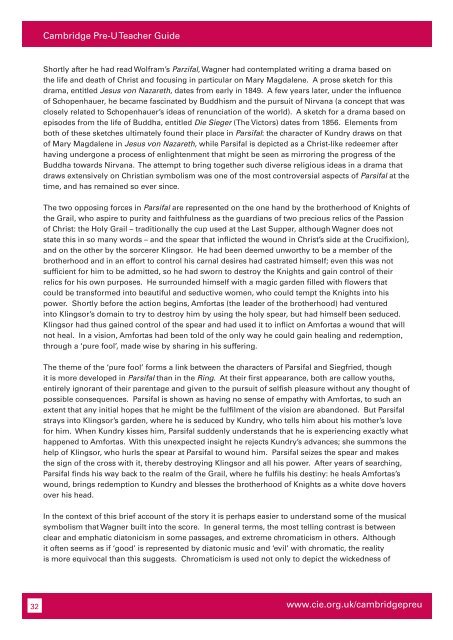Teacher's Guide Cambridge Pre-U MUSIC Available for teaching ...
Teacher's Guide Cambridge Pre-U MUSIC Available for teaching ...
Teacher's Guide Cambridge Pre-U MUSIC Available for teaching ...
Create successful ePaper yourself
Turn your PDF publications into a flip-book with our unique Google optimized e-Paper software.
32<br />
<strong>Cambridge</strong> <strong>Pre</strong>-U Teacher <strong>Guide</strong><br />
Shortly after he had read Wolfram’s Parzifal, Wagner had contemplated writing a drama based on<br />
the life and death of Christ and focusing in particular on Mary Magdalene. A prose sketch <strong>for</strong> this<br />
drama, entitled Jesus von Nazareth, dates from early in 1849. A few years later, under the influence<br />
of Schopenhauer, he became fascinated by Buddhism and the pursuit of Nirvana (a concept that was<br />
closely related to Schopenhauer’s ideas of renunciation of the world). A sketch <strong>for</strong> a drama based on<br />
episodes from the life of Buddha, entitled Die Sieger (The Victors) dates from 1856. Elements from<br />
both of these sketches ultimately found their place in Parsifal: the character of Kundry draws on that<br />
of Mary Magdalene in Jesus von Nazareth, while Parsifal is depicted as a Christ-like redeemer after<br />
having undergone a process of enlightenment that might be seen as mirroring the progress of the<br />
Buddha towards Nirvana. The attempt to bring together such diverse religious ideas in a drama that<br />
draws extensively on Christian symbolism was one of the most controversial aspects of Parsifal at the<br />
time, and has remained so ever since.<br />
The two opposing <strong>for</strong>ces in Parsifal are represented on the one hand by the brotherhood of Knights of<br />
the Grail, who aspire to purity and faithfulness as the guardians of two precious relics of the Passion<br />
of Christ: the Holy Grail – traditionally the cup used at the Last Supper, although Wagner does not<br />
state this in so many words – and the spear that inflicted the wound in Christ’s side at the Crucifixion),<br />
and on the other by the sorcerer Klingsor. He had been deemed unworthy to be a member of the<br />
brotherhood and in an ef<strong>for</strong>t to control his carnal desires had castrated himself; even this was not<br />
sufficient <strong>for</strong> him to be admitted, so he had sworn to destroy the Knights and gain control of their<br />
relics <strong>for</strong> his own purposes. He surrounded himself with a magic garden filled with flowers that<br />
could be trans<strong>for</strong>med into beautiful and seductive women, who could tempt the Knights into his<br />
power. Shortly be<strong>for</strong>e the action begins, Am<strong>for</strong>tas (the leader of the brotherhood) had ventured<br />
into Klingsor’s domain to try to destroy him by using the holy spear, but had himself been seduced.<br />
Klingsor had thus gained control of the spear and had used it to inflict on Am<strong>for</strong>tas a wound that will<br />
not heal. In a vision, Am<strong>for</strong>tas had been told of the only way he could gain healing and redemption,<br />
through a ‘pure fool’, made wise by sharing in his suffering.<br />
The theme of the ‘pure fool’ <strong>for</strong>ms a link between the characters of Parsifal and Siegfried, though<br />
it is more developed in Parsifal than in the Ring. At their first appearance, both are callow youths,<br />
entirely ignorant of their parentage and given to the pursuit of selfish pleasure without any thought of<br />
possible consequences. Parsifal is shown as having no sense of empathy with Am<strong>for</strong>tas, to such an<br />
extent that any initial hopes that he might be the fulfilment of the vision are abandoned. But Parsifal<br />
strays into Klingsor’s garden, where he is seduced by Kundry, who tells him about his mother’s love<br />
<strong>for</strong> him. When Kundry kisses him, Parsifal suddenly understands that he is experiencing exactly what<br />
happened to Am<strong>for</strong>tas. With this unexpected insight he rejects Kundry’s advances; she summons the<br />
help of Klingsor, who hurls the spear at Parsifal to wound him. Parsifal seizes the spear and makes<br />
the sign of the cross with it, thereby destroying Klingsor and all his power. After years of searching,<br />
Parsifal finds his way back to the realm of the Grail, where he fulfils his destiny: he heals Am<strong>for</strong>tas’s<br />
wound, brings redemption to Kundry and blesses the brotherhood of Knights as a white dove hovers<br />
over his head.<br />
In the context of this brief account of the story it is perhaps easier to understand some of the musical<br />
symbolism that Wagner built into the score. In general terms, the most telling contrast is between<br />
clear and emphatic diatonicism in some passages, and extreme chromaticism in others. Although<br />
it often seems as if ‘good’ is represented by diatonic music and ‘evil’ with chromatic, the reality<br />
is more equivocal than this suggests. Chromaticism is used not only to depict the wickedness of<br />
www.cie.org.uk/cambridgepreu
















